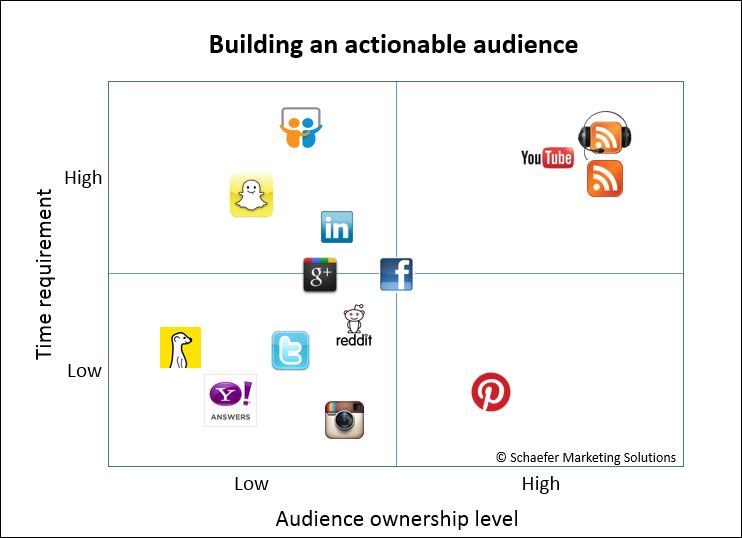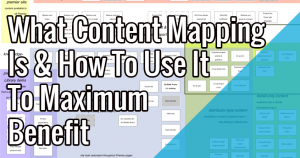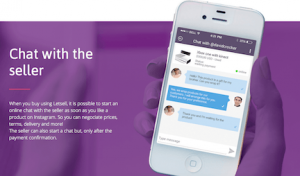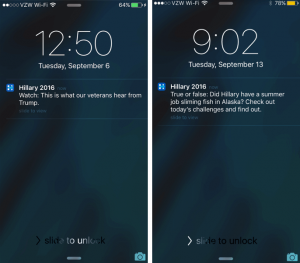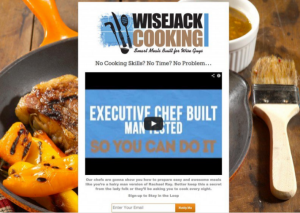
One of the most common business dilemmas is figuring our where to start with social media marketing. Today, I would like to introduce a few high level ideas to help you decide where to put your time for the best results for your business. As with anything in life, there is often a trade-off between effort and business benefits and social media is no different.
I need to make a very important point right up front. There is NO common solution or strategy that fits every business. What I am proposing here should not be taken as “The Gospel.” This post contains broad generalizations — you still have to use common business sense to determine what fits best for you. Okay? Let’s get started.
The ultimate goal
There are lots of amazing things a business can do to create benefits from the social web — customer service, business intelligence, and creating awareness to name a few. But today I want to assume that your primary goal is to create an actionable audience — that is, develop an online community who will create some business benefit for you over time.
Let’s cover a few key concepts about building that actionable social media audience:
Weak links versus strong links — A common misconception is that “audience” equals “action. It does not. If you are reading this post, you might have discovered it through Twitter or Facebook. But if you have no emotional connection to me as a blogger, are you going to hire me? Buy my marketing books? No. Social media marketing simply opens up the door for connections through weak relational links. You still have to do the hard work to turn those folks into buying customers.
Reliable reach — My friend Jay Baer coined a term I like very much: “reliable reach.” If you tweet something, it’s kind of like throwing a message in a bottle into the ocean, isn’t it? You don’t really know who will read it …or if anyone will. However, if somebody subscribes to a blog or YouTube channel, they are asking for your content. There is a good chance they will actually see it. The goal of social media marketing is to direct more audience member to subscriptions — reliable reach — over time, There is generally a relationship between the time you put into social media and the level of reliable reach you attain.
Role of content — Content is the catalyst that leads to awareness on the web. Awareness may then lead to engagement and engagement may lead to trust, and even loyalty over time. Creating, curating, and distributing content is the economic driver of social media success. The different platforms require different types of content, some simple, some complex. This is important for a business to consider.
The best social media platform for your organization
The default position for social media marketing seems to be Facebook. While Facebook is undeniably important, let’s stack it up to the other platforms in the context of our ultimate goal of building an actionable audience. In this analysis, I am covering the top social media platforms based on visits, plus a few others like Slideshare and Meerkat for fun. Here’s my analysis:
If you were to draw an arrow from the lower left quadrant (low time required, low audience ownership) to the upper right quadrant (high time required and high audience ownership, it would also present a useful continuum of the less complex content to more complex content requirements. Let’s look at each platform starting roughly from the lower left to the upper right.
 Meerkat/Periscope – Streaming video is hot right now but at this point the genre is limited in its ability to attain reliable reach. You can stream live from an event or from your home but it has a limited opportunity for sustaining an audience because who you reach is dependent on who is available in that moment.
Meerkat/Periscope – Streaming video is hot right now but at this point the genre is limited in its ability to attain reliable reach. You can stream live from an event or from your home but it has a limited opportunity for sustaining an audience because who you reach is dependent on who is available in that moment.
But keep your eye on this space. I think over time, these platforms will improve in their ability to create reliable reach as users figure out creative new uses for regularly-scheduled programming and even integrating with traditional media. Of all the platforms listed here, I think this one has the most potential to shift to the upper right in terms of sustaining an actionable audience.
 Yahoo Answers — A lot of people still love to visit old school forums and Q&A sites like Yahoo Answers. Recent research from Edison suggests that more people visit forums than blogs. However a forum is somewhat limited in creating a sustainable and actionable audience. You might answer questions for an entirely new audience each time you visit the site. In this case, Yahoo really owns the audience, not you.
Yahoo Answers — A lot of people still love to visit old school forums and Q&A sites like Yahoo Answers. Recent research from Edison suggests that more people visit forums than blogs. However a forum is somewhat limited in creating a sustainable and actionable audience. You might answer questions for an entirely new audience each time you visit the site. In this case, Yahoo really owns the audience, not you.
 Twitter is not as simple as it might appear. Although you are limited to 140 characters, it can be quite difficult creating something meaningful in that small space.
Twitter is not as simple as it might appear. Although you are limited to 140 characters, it can be quite difficult creating something meaningful in that small space.
Twitter stands alone in its ability to create a huge, relevant audience quickly, but since you cannot target groups of followers with messages (at least yet), it sometimes feels like you are throwing a message out to a big silent world. The platform is great at making initial connections which can lead to reliable reach on another platform like a blog or podcast.
 Instagram — One of the reasons this platform is so popular is that it is so easy to use. Snap a photo and post. This is one of the reasons that Instagram is used at work more than any other platform (85% of its users do so!). In fact it is probably unique among platforms in its opportunity to create connection with relatively little work. Another advantage is that there is no timeline editing. Every subscriber has an equal chance of seeing what you post. But like Twitter, your content is somewhat ephemeral as it slowly sinks to the bottom of the news feed.
Instagram — One of the reasons this platform is so popular is that it is so easy to use. Snap a photo and post. This is one of the reasons that Instagram is used at work more than any other platform (85% of its users do so!). In fact it is probably unique among platforms in its opportunity to create connection with relatively little work. Another advantage is that there is no timeline editing. Every subscriber has an equal chance of seeing what you post. But like Twitter, your content is somewhat ephemeral as it slowly sinks to the bottom of the news feed.
 Pinterest is the only platform in the box of “low work, high reach.” Primarily, you are creating audience value by curating content (rather than creating content) from other sources on the web into logical pages that will inspire and entertain. And if you do an excellent job with curation, you can build a very loyal audience. One sign of the platform’s ability to create an active audience is that “pinned” items drive more web traffic than any other platform.
Pinterest is the only platform in the box of “low work, high reach.” Primarily, you are creating audience value by curating content (rather than creating content) from other sources on the web into logical pages that will inspire and entertain. And if you do an excellent job with curation, you can build a very loyal audience. One sign of the platform’s ability to create an active audience is that “pinned” items drive more web traffic than any other platform.
 Google+ is the most mysterious of all the platforms. Is it vital and vibrant? Or, is it a desolate ghost town? The answer is, “both.”
Google+ is the most mysterious of all the platforms. Is it vital and vibrant? Or, is it a desolate ghost town? The answer is, “both.”
Despite the cries of its stalwart defenders, Google+ is simply not a mainstream public platform. Most people simply don’t care about the SEO benefits. It’s never mentioned on TV, you don’t see businesses asking for a follow on G+, and it’s not on the radar screen of Millennials. So your access to mainstream consumers is extremely limited.
However, G+ is nearly unparalleled in its ability to create passionate communities of fans who rally around a cause, a subject, or a person. There are wonderful communities dedicated to photography, cars, and tech, for example. You can certainly build an actionable audience on G+ but the platform trends toward the left on the chart because of its limited scope.
 Facebook is like a gambling addiction. You keep putting more and more money into it because the idea of a huge payoff is so intoxicating. You can’t ignore Facebook. It’s huge and popular but in many ways, it’s the most difficult platform to navigate.
Facebook is like a gambling addiction. You keep putting more and more money into it because the idea of a huge payoff is so intoxicating. You can’t ignore Facebook. It’s huge and popular but in many ways, it’s the most difficult platform to navigate.
- To really succeed, you must be a conversational brand, or become one (not easy or cheap).
- It takes a lot of money and effort to build an audience — but then Facebook keeps you away from them. Facebook severely limits access to your audience. Read this post on the decline in Facebook organic reach to learn more about that.
- While Facebook seems simple (and free!) it’s not. To get your content on to a timeline, you probably need to spend a lot on quality, promotion, or both.
If you are celebrity or a beloved and established brand in your community, Facebook might be ideal. If you are a regional company that hauls hazardous waste, maybe not. For that reason, it’s difficult to put it in any one place on this diagram. There are so many complicating factors.
 Reddit hosts an unparalleled number of content-centric communities. It’s kind of a combination of Google+, Forums, and blogging. Like G+, people are passionate about the platform and their communities. Like forums, people will go to great lengths to help each other, and like blogging, there is an emphasis on thought-provoking, original content. There are Reddit communities for almost any topic but forget about promoting your local pizza business. Any form of commercial display is likely to get you kicked out.
Reddit hosts an unparalleled number of content-centric communities. It’s kind of a combination of Google+, Forums, and blogging. Like G+, people are passionate about the platform and their communities. Like forums, people will go to great lengths to help each other, and like blogging, there is an emphasis on thought-provoking, original content. There are Reddit communities for almost any topic but forget about promoting your local pizza business. Any form of commercial display is likely to get you kicked out.
 LinkedIn — A year ago, LinkedIn would have been down low in the “low work-low audience” block with Twitter. Sure, it’s a great place to look for a job but there just was not much socialization going on there. That has all changed with its new emphasis on publishing. Now, any member can use LinkedIn as a blogging forum and tap into the potential exposure of LinkedIn’s vast audience.
LinkedIn — A year ago, LinkedIn would have been down low in the “low work-low audience” block with Twitter. Sure, it’s a great place to look for a job but there just was not much socialization going on there. That has all changed with its new emphasis on publishing. Now, any member can use LinkedIn as a blogging forum and tap into the potential exposure of LinkedIn’s vast audience.
For those who have not been able to patiently build a dedicated blog community, this is an amazing opportunity, and scores of people are finally finding an audience for their work. The main limitation is that this is a business site. You probably aren’t going to publish about your favorite sports team or restaurant unless there is a business lesson behind it. And of course, ultimately, LinkedIn still owns the audience.
 Snapchat — You might be thinking that I have this in the wrong place on this chart. How hard could it be to create content for Snapchat? You just post photos right? And doesn’t Snapchat offer among the most engaged and passionate users?
Snapchat — You might be thinking that I have this in the wrong place on this chart. How hard could it be to create content for Snapchat? You just post photos right? And doesn’t Snapchat offer among the most engaged and passionate users?
You would be right on both counts. HOWEVER. I am writing this from the perspective of corporate marketing success. Let me give you an example of how difficult this platform is to master.
Disney recently hired well-known Snapchat artists to create snaps throughout their park over a 24-hour period. It was a great success and Disney garnered 50,000 new followers from the stunt. So the first lesson is that it takes some effort to attract new followers. The second lesson is, the art created for this program was not easy, not cheap, and it lasted just a few moments, never to be re-purposed again. The final point is…now what? Once Disney had the new followers, how are they going to keep that edgy millennial art going to sustain the gains? Snapchat is fun and easy unless you’re a brand marketer. Success requires an in-the-moment style of goofiness not smiled upon by the corporate attorneys.
 Slideshare — I wrote a blog post. It was viewed 7,000 times. I turned it into a Slideshare presentation. It was viewed 110,000 times. Any questions?
Slideshare — I wrote a blog post. It was viewed 7,000 times. I turned it into a Slideshare presentation. It was viewed 110,000 times. Any questions?
Slideshare has the potential for incredible reach to an entirely new audience. But it is also very difficult to be successful because there is a certain art involved in telling a compelling visual story through slides. You need the content, the images, the great story. It can’t be too short, it can’t be too long. You can’t really DIY it on the graphics. And the Slideshare audience is still limited, by far the smallest platform covered here, which is why audience ownership is limited. Only 15 percent of marketers are actively using it.
Still, it is growing, owned by LinkedIn, and highly indexed by Google. If you put in the work there is lots of opportunity to build a presence that leads to an actionable community especially if your competitors aren’t there yet.
 Blogging, Podcasting, and Video — I am grouping these three titans in the upper right corner because they are all similar and distinctive in their importance. The opportunities for these three platforms:
Blogging, Podcasting, and Video — I am grouping these three titans in the upper right corner because they are all similar and distinctive in their importance. The opportunities for these three platforms:
- You generally must create original, distinctive content to stand out. Not easy. Not cheap.
- The opportunity for reliable reach is unprecedented because people subscribe to your content. In other words, not only do they consume it, they expect it.
- Consistently publishing a blog, video series, or podcast allows you develop important, loyal connections over time. These are people specifically interested in you and they are actionable.
- There are virtually no limitations to the type of audience you can reach.
- You own the content. It is permanent and can be re-purposed for years.
- This represents a proprietary audience accessible by you.
Under certain circumstances, you can build a relevant, actionable, passionate audience on any of these social media platforms. However, for most businesses, the engine for social media success begins with the “rich content” provided by a blog, video series, or podcast. An investment in this content also provides an opportunity for massive exposure compared to a simple tweet of Facebook post.
Again, I would like to emphasize that there are many more opportunities within these platforms than I could cover in a short, generalized blog post. There are many exceptions to these “rules.” But I hope presenting this in the unique perspective of effort versus audience has been useful and thought-provoking. The comment section is yours!
(156)

